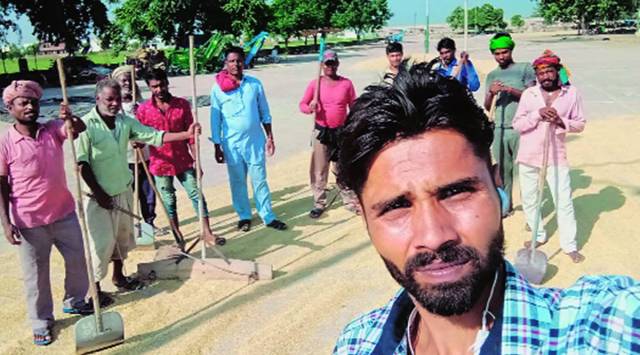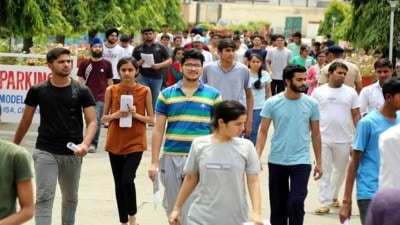- India
- International
Punjab mandi unrest includes labourers: ‘Govt playing with lives of lakhs’
The mandis also employ women, who painstakingly clean the hay from the wheat, buying the hay later to further separate grains for meagre earnings.
 Labourer Diwakar Kumar at Khanna Mandi
Labourer Diwakar Kumar at Khanna Mandi FOR five years now, Diwakar Kumar has been coming to the Khanna Mandi in Punjab, from his village Dhruvganj in Bhalgpur, Bihar, to work as a labourer. The half-the-year that he is here, over Kharif and Rabi seasons, Kumar earns around Rs 12,000 monthly, saving up to Rs 9,000.
The earnings are double what he could earn at home, “with no government jobs and private jobs only paying Rs 5,000-6,000”, says the 23-year-old graduate, who supports his seven siblings due to his father’s illness. However, that may be about to end, Kumar says, mentioning the buzz that farmers might stop bringing their produce to agricultural produce marketing committees (APMC) following a recently passed legislation in Parliament. “If traders and big companies start purchasing from the farmers at their fields, I’ll be out of guaranteed work,” Kumar says, a fear shared by the other labourers at Punjab’s biggest grain market, many of them from Bihar.
Kumar claims to speak from experience. “In Bihar, since the APMCs were dismantled in 2006, farmers have been selling their crops at much lower rates and not much labour work is available at mandis,” he says. “Hamara kya hoga kuchch pata nahin (I don’t know what will happen to us).”
Abhinandan Yadav says he was 10 when he first arrived at the Khanna Mandi to work as a labourer, from village Phanhan in Madhepura, Bihar. He is 45 now. “I have done all the work here at the mandi, unloading, loading, filling of grains etc,” says Yadav, adding that back home in Bihar, they have nothing to do.
Mahesh Kumar, 40, says 20 of them at Amritsar’s Bhagtanwala Mandi are from Saharsa in Bihar. The mandi is busy these days with the arrival of Basmati 1509. Mahesh says they first “ran to Punjab” after work in Bihar mandis went down after 2006. “Where will we go now?”

The mandis also employ women, who painstakingly clean the hay from the wheat, buying the hay later to further separate grains for meagre earnings. Dhano, 55, has been doing this work for over three decades at the mandi. “I purchase the waste at Rs 100 to Rs 200 per quintal and then pick the grains. Sometimes I manage 2 kg grain from one quintal waste and sometimes even 10 kg. I keep some of the grains for my family and sell the surplus, earning up to Rs 10 per kg.” It may not sound much, says Dhano, but can mean earnings of Rs 4,000-5,000 a month apart from grains for her family for the whole year.
Darshan Lal, the president of the Anaj Mandi Mazdoor Union, Khanna Market, says his forefathers first started working as labourers at the mandi. He says 40,000 labourers and around a thousand women sifting the waste are employed at the mandi, which handles 40 lakh bags of paddy (one bag weighing 50 kg) and 20-25 lakh bags of wheat (35-37.5 kg per bag) every year.
Rakesh Tuli is a member of the standing committee of the Punjab Mandi Board and the president of the Anaj Mandi Mazdoor Union Punjab, which came into existence in 1958, then known as the Galla Mazdoor Union. “We have 152 big grain markets and around 1,700 block- and village-level mandis cum purchase centres, in which around five lakh migrant labourers and a couple of lakh labourers from Punjab work. All of them will be jobless if grains stop coming to mandis,” he says. “How can the government play with the lives of lakhs?”
Apr 18: Latest News
- 01
- 02
- 03
- 04
- 05






































